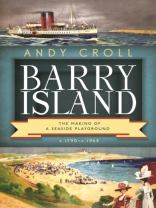Barry Island was one of the most cherished leisure spaces in twentieth-century south Wales, the playground of generations of working-class day-trippers. This book considers its rise as a seaside resort and reveals a history that is much more complex, lengthy and important than has previously been recognized. As conventionally told, the story of the Island as tourist resort begins in the 1890s, when the railway arrived in Barry. In fact, it was functioning as a watering place by the 1790s. Yet decades of tourism produced no sweeping changes. Barry remained a district of ‘bathing villages’ and hamlets, not a developed urban resort. As such, its history challenges us to rethink the category of ‘seaside resort’ and forces us to re-evaluate Wales’s contribution to British coastal tourism in the ‘long nineteenth century’. It also underlines the importance of visitor agency; powerful landowners shaped much of the Island’s development but, ultimately, it was the working-class visitors who turned it into south Wales’s most beloved tripper resort.
Tabela de Conteúdo
Acknowledgements
List of Illustrations
Author’s Note
Introduction
Chapter 1 ‘Much Frequented During the Bathing Season’: Barry Island and Welsh Coastal Tourism, c. 1780-c. 1860
Chapter 2 ‘That Favourite Place’: Cardiff’s Bathing Resort, c. 1860-1877
Chapter 3 Visitors ‘Mercilessly’ Turned Away: The Island Closed, 1878-1884
Chapter 4 Reclaimed, 1884-c.1890
Chapter 5 An ‘El Dorado Where Soft Winds Blow’: Resort Boosterism Flourishes in the 1890s
Chapter 6 ‘Awake ye Sluggards!’ Resort Development Flounders, c. 1900-1914
Chapter 7 ‘They Sweep Down on the Place and Take Possession of It’: Trippers Triumphant, c. 1890-c. 1910
Chapter 8 Barry-on-Sea? The Tripper Resort Consolidated, 1914-c.1965
Conclusion
Bibliography
Sobre o autor
The book has been written with a view to contributing to the academic study of the history of coastal tourism / seaside resorts, so academic researchers and undergraduate students will find it useful. However, it will also appeal to those interested in the history of seaside resorts generally – and Barry Island specifically.












